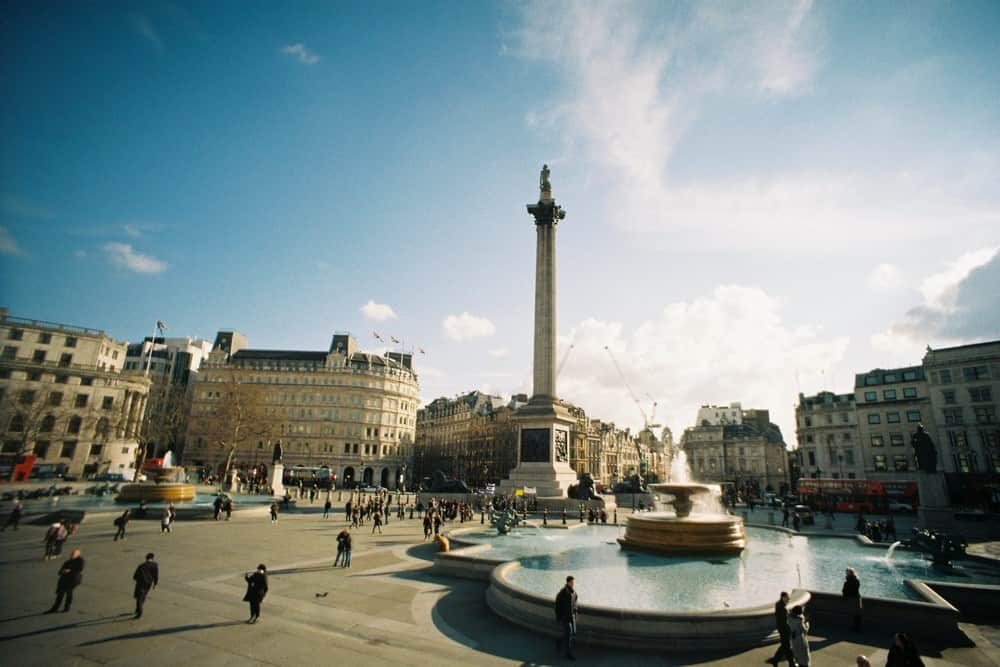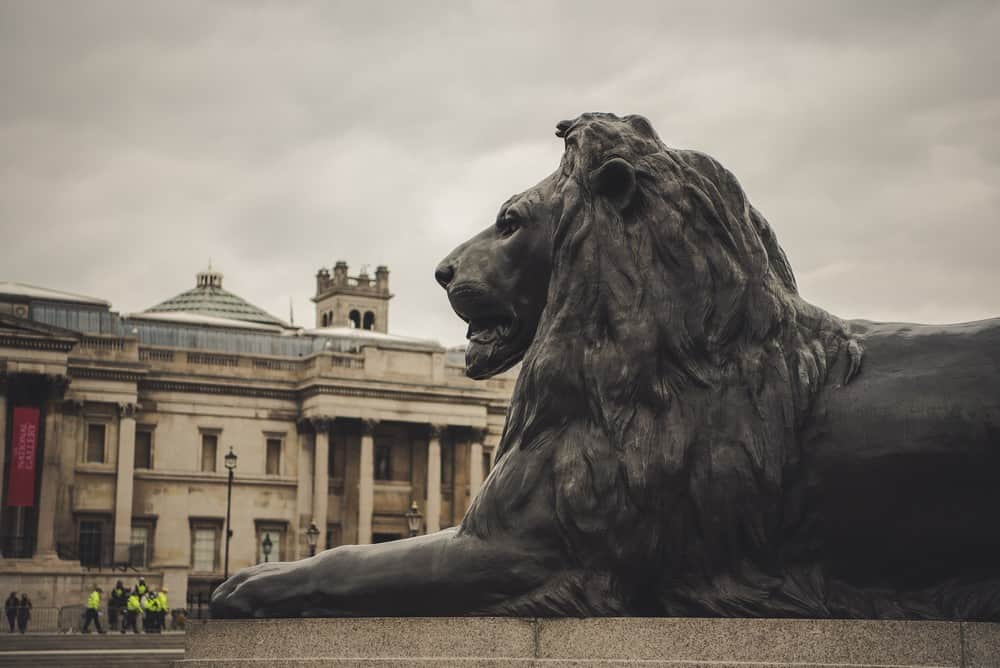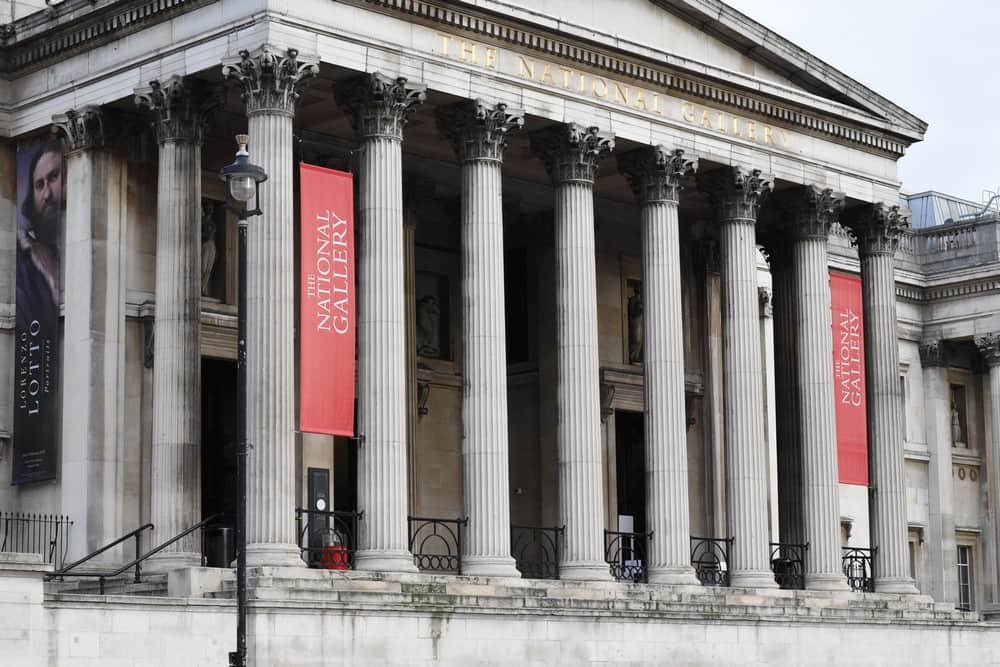Written by taxi tour guide Moses
Trafalgar Square is the focal point for protests, revelry and victory celebrations, however it was only in 1835 that the area became known by this name. Trafalgar Square may be one of London’s most famous areas, but do you know the history behind it? Learn everything you need to know about Trafalgar Square and its iconic landmarks here.
Edward I (1272-1307) kept his falcons and hawks here, as it was the site of the Royal Mews. By the time of Henry VII (1485-1509) it had transitioned into the stabling area for Whitehall Palace – did you know, the National Gallery stands on the site of part of those very mews?
By the time of the English civil war from 1642-1651, barracks had been built to house the Parliamentary forces after the battle of Naseby in 1645 – approximately 4,500 Cavalier (Royalist, those who fought on the side of Charles I) prisoners were held there.
By 1830, following rebuilding and modelling by architectural giants such as William Kent, much of the area was demolished in preparation for the Charing Cross improvement scheme. John Nash was the architect – he was famous for Nash Terraces, Regents Park, Regent Street and Brighton Pavilion. This created Trafalgar Square as we know it today.
Unfortunately, John Nash did not live to see his plan through. Charles Barry took over the project, creating a modern square to match any of the European piazzas and plazas. It was named after the Battle of Trafalgar, in which the British hero Admiral Horatio Nelson defeated the combined French and Spanish fleet off the coast of Spain on October 21st 1805. This battle is where Nelson sent the signal containing words that would become immortalised as part of English folklore:
“England Expects That Every Man Will Do His Duty”.
The Nelson Monument

Trafalgar Square is famous for the Nelson Monument commonly known as Nelson’s Column. Once completed, Sir Robert Peel (Prime Minister of the day) described it as ‘the finest site in Europe’.
The Column is by William Railton and is 172 feet high, the same height as the main mast on Nelson’s flagship HMS Victory (the world’s oldest commissioned warship). It is a fluted Corinthian column made from Devon granite, with a statue that is 17 feet 41⁄2 inches tall at the top. The statue is of a British hero considered by many to be the greatest naval commander: Viscount Nelson of the Nile and Burnham Thorpe, by the sculptor and designer E.H Baily. It has been said that if the statue of Nelson could be clearly seen, it in itself would be declared a masterpiece!
Lawrence Durrell quoted “Now stiff on a pillar with a phallic air Nelson stylites in Trafalgar Square reminds the British what they once were.”
Trafalgar Day occurs each year on October 21st and a ceremony is held on board Victory marking the anniversary of the Battle of Trafalgar. Britain’s wealth, prosperity and status on the world stage can be traced back to that day!
Captured Cannon
The four reliefs at the foot of the Monument were cast from cannon captured in Nelson’s famous battles, commemorating his greatest victories:
- The Battle of Cape St Vincent, originally designed by Musgrave Lewthwaite Watson, who died shortly after making a small model of it. It was completed by Fredrick Woodington
- The Battle of the Nile, by Fredrick Woodington
- The Battle of Trafalgar (The Death of Nelson), by John Edward Carew
It has been said that the four large lanterns found here are from HMS Victory. One stands atop the smallest police station (more on this later). The others are in the corners of the Square. Sadly, some say there is no connection to HMS Victory.
These beautiful panopticon lamps are said to be designed by Sir Charles Barry and according to Nikolaus Pevsner, they were made by the Bude Light Company approximately 40 years after the Battle of Trafalgar! (For the correct answer ask one of our guides…)
Four Lions

The four world-famous couchant lion sculptures by Sir Edwin Landseer (1802-73) are virtually identical, however there are very subtle differences. They were all cast by Baron Marochetti and placed in 1867.
Landseer had acquired a dead lion from London Zoo, however by the time he came to sculpting the paws they had decomposed. So instead, he based the paws on those of his pet dog.
The fountains were not part of Charles Barry’s design and were installed by Edwin Lutyens in 1939. They were memorials to commemorate admirals Beatty and Jellicoe, whose victory at the Battle of Jutland is said to have shortened the First World War considerably. Their busts are placed in alcoves in the north wall. While you are there, look out for the set of imperial measurements – yard, foot and inch – then relax with a cup of tea or coffee and watch the world go by at the Café On The Square.
Britain’s Smallest Police Station
Located in the south-east corner of Trafalgar Square is an overlooked world record holder: Britain’s smallest police station. Its main purpose was to hold a single police officer… think of it as a 1920s CCTV camera and a place to shelter from the weather!
It was built in 1926 inside an ornamental light fitting for the Metropolitan Police. A direct phone line back to Scotland Yard was installed in case reinforcements were needed in times of trouble. Whenever the police phone was picked up, the ornamental light fitting at the top of the box started to flash, alerting any nearby police officers of impending trouble.
Pedestrianisation
In 2002–2003, Sir Norman Foster led the World Squares for All project which resulted in the north side of Trafalgar Square being pedestrianised, with steps leading up to the terrace in front of the National Gallery. The end result looked as if Charles Barry had created the steps and terrace himself.
Charles I Statue
On the south side of the square is the equestrian statue of Charles I (1625–1649), also known as Charles I island, in Charing Cross. This bronze statue was made in 1633 by Hubert le Sueur. It was acquired for the crown and set up here in 1675. The carved work of the pedestal is by Joshua Marshall but it is believed to be the design of Wren and Gibbons. The sculptor’s name can be seen on the horse’s hooves. Made during Charles I’s reign, it is London’s oldest bronze. In 1649, Parliament under The Lord Protector Oliver Cromwell ordered that it be destroyed, however it was hidden and reappeared triumphantly at the Restoration of the monarchy. It was erected in its current position in 1675. In World War I it was protected by sandbags and in World War II, the statue was moved to Mentmore in Buckinghamshire. A temporary brick structure was erected to protect the carved plinth.
Originally on the site was Queen Eleanor’s Cross, placed here by her husband Edward I. A copy of the gothic memorial can be seen outside Charing Cross Station, close to the entrance to the Royal Mews. The cross, more of a gothic monument, was here from approximately 1291-1647 when, under the interregnum, it was pulled down. Charles I was beheaded on a scaffold outside the Banqueting Hall in 1649 just a short trip down Whitehall. Every January his death is commemorated on the Sunday closest to the 30th, wreaths are laid at this statue, and prayers are said at the site of his execution. You will often see a single red rose attached to the side of the plinth.
This location also serves as the centre of London for the purposes of measuring distances, i.e. London to Washington DC, London to Chicago etc. As well, street numbering convention states that the low numbers in a London street should be at the end closest to the site.
Here is a very early photo of the statue and the view down Whitehall.
South Africa House
South Africa House was designed by Sir Herbert Baker in 1935. The gilt springbok over the entrance is by Charles Wheeler. Here, the then President Nelson Mandela gave a speech.
St Martin-in-the-Fields
St Martin-in-the-Fields is on the north east side of the square, built by James Gibbs in a synthesis of Baroque and Palladian styles. Built in 1722-26, it has a beautiful crypt café and hosts concerts and charity events.
But why St Martin-in-the-Fields? When it was built atop a large mound, the area was open fields. It is believed that there was a place of worship on this site dating back to the 1200s. This is where the first religious broadcast in Britain took place in 1924. St Martin-in-the-Fields is also the parish church of Buckingham Palace and 10 Downing Street!
The National Gallery

Building work on the neoclassical National Gallery building started along the north side of the square in 1832 and was completed in 1838 by the Greek Revival architect William Wilkins. He also submitted plans for the design of Trafalgar Square, however he sadly died in 1839. Sir Charles Barry was eventually chosen from the other entries.
The National Gallery has been enlarged numerous times to house the 2,000+ art works, with the last addition of the Sainsbury Wing in 1991 by the American architect Robert Venturi. There are plans for further building and restoration works to take place, to be completed by 2024.
The National Gallery houses one of the best collections of western European art from 1250–1900 in the world, giving it international significance. It has an incredible interactive program for the whole family, so it is well worth exploring the family events.
One of my favourite paintings, which gives me goosebumps every time, is The Ambassadors by Hans Holbein the Younger.
There are lawn statues of:
- George Washington, located on the east lawn. It is a bronze replica of the statue that stands in the State Capitol building in Richmond, Virginia, by Jean-Antoine Houdon. It was offered to the United Kingdom to celebrate the 300th anniversary of the founding of the Commonwealth of Virginia. Unveiled in 1921 at the eastern end of the lawn, it was then moved to its current position in 1948 to create symmetry with the statue of James II on the west lawn.
- King James II in Roman dress. This is a bronze statue by sculptor and woodcarver Grinling Gibbons, who completed it in 1686. Originally displayed outside Whitehall Palace and moved several times, it was placed in its current location on the west lawn of the National Gallery in 1948.
The gallery is part of the national psyche and during World War II, the collection was moved to old mining caves in Wales to protect it from destruction. However, one masterpiece per month was shown, putting it at the same risk as Londoners
Canada House
Canada House is positioned on the western side of Trafalgar Square. It is a visible symbol of Canada in London and is the High Commission’s Consular, providing full consular and passport services for Canadians.
Built in the Greek Revival style, it was designed and built between 1824 and 1827 by the leading architect of the day Robert Smirke, whose buildings include the British Museum and Covent Garden Theatre (Royal Opera House).
The building is located at what was the eastern end of London’s club land – indeed, it was a gentleman’s club called the Union Club, whose members included the Duke of Wellington, Sir Robert Peel, Cecil Rhodes and Charles Dickens.
It then went on to become the Royal College of Physicians and was first secured by the Government of Canada in 1923. The Prime Minister of the day, Mackenzie King, hailed it as possibly ‘the finest site in London and, being in London, the finest in the world’. King George V officially opened Canada House on June 29th 1925 and it was reopened by Queen Elizabeth II in 1998 after extensive renovations.
Christmas Tree
During those dark and terrifying times when Nazi forces occupied Norway in the early days of World War II, Norway’s royal family and government fled, taking refuge in London for five years. In 1947, the city of Oslo sent a Christmas tree to London as a thank you for Britain’s wartime support. The gift has become an annual tradition that continues to this day.
The most recent tree was an 85-year-old Norwegian spruce, standing around 24 meters (79ft) tall. It was felled in an Oslo forest in November and was lit in Trafalgar Square in December.
Lists of potential Christmas trees are kept each year and they are given extra care. Even then, only one in 20 trees will make the cut and be found suitable for Trafalgar Square. When the tree has been selected there is a special felling ceremony hosted by the Mayor of Oslo, with the Lord Mayor of Westminster and the British Ambassador to Norway also in attendance. The tree is then transported to the harbour of Brevik. It travels across the North Sea and to protect it from seawater, the tree is stored below deck. The ship docks at Immingham in Lincolnshire or Harwich in East Anglia, then continues its journey to London and Trafalgar Square.
Black Taxi Tour London is lucky to have a member who, as a child, got to work with his father to help put up the Christmas tree. It is a gift that is always very gratefully received.
Bloody Sunday
London’s Bloody Sunday took place on November 13th 1887 in Trafalgar Square. It was the culmination of months of increasing tension between the authorities and Londoners over the right to demonstrate in Trafalgar Square, demands for home rule in Ireland, and rising unemployment and social conditions. All these factors added to the powder keg, so all that was needed was a spark!
Sir Charles Warren, Commissioner of Police, banned all meetings in Trafalgar Square on November 8th. This was an outright challenge to the freedom of speech and the right to protest based on the Magna Carta. It outraged radicals across London and a meeting was scheduled for the following Sunday in Trafalgar Square, a recognised flash point for political demonstrations. Among the demonstrators that day were:
- Eleanor Marx, (daughter of Carl Marx)
- Annie Besant
- William Morris
- George Bernard Shaw
Various giants of the early British labour movement converged on Trafalgar Square that day! Police tried to disperse the crowd of approximately 10,000 people, with approximately 400 soldiers in reserve. Fighting and rioting broke out and several people were injured. The current wave of demonstrations by Extinction Rebellion, BLM and myriad other causes is nothing new to Trafalgar Square.
Celebration and Victory
Trafalgar Square is the scene of revelry and celebration, from the England football team winning the world cup in 1966, the England Rugby team winning the world cup in 2003, to New Year’s Eve celebrations. However, there are none that can rival the celebrations of VE Day 1945.
Europe had been under the Nazi jackboot and it was this small island nation that stood alone and gave refuge to hope and freedom from tyranny. The nation rallied her allies under the leadership of then Prime Minister Sir Winston Churchill, who said in his first speech to Parliament:
“I would say to the House, as I said to those who have joined this government: “I have nothing to offer but blood, toil, tears and sweat.”
Going on to give his speech to the nation after the withdrawal of the British Expeditionary Force from Dunkirk:
“We shall not flag or fail. We shall go on to the end, we shall fight in France, we shall fight on the seas and oceans, we shall fight with growing confidence and growing strength in the air, we shall defend our island, whatever the cost may be, we shall fight on the beaches, we shall fight on the landing grounds, we shall fight in the fields and in the streets, we shall fight in the hills; we shall never surrender, and even if, which I do not for a moment believe, this island or a large part of it were subjugated and starving, then our empire beyond the seas, armed and guarded by the British fleet, would carry on the struggle, until, in God’s good time, the New World, with all its power and might, steps forth to the rescue and the liberation of the old.”
It was that leadership, combined with that of King George VI (the Queen’s father) that led to our victory on May 8th 1945.
Crowds like those on that day and evening had never been seen before and are not likely to be seen again. It is the only known occasion when the now Queen, Princess Elizabeth, and her sister Princess Margaret, partied among her future subjects. Their parents, George VI and Queen Elizabeth, let the young princesses leave the palace in a group of 16, blending easily into the crowd – Princess Elizabeth was in her Auxiliary Territorial Service uniform, like so many others, and Margaret, then just 14, was in smart civilian clothes.
In a rare interview in 1985 the Queen called it ‘one of the most memorable nights of my life.’
I do not believe there is anywhere else in the world that you will find all this history, culture and social interaction. Trafalgar Square is wonderful and unique.




